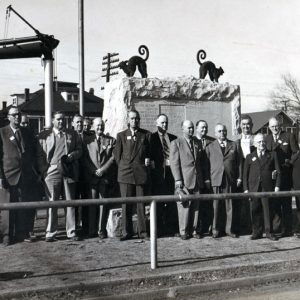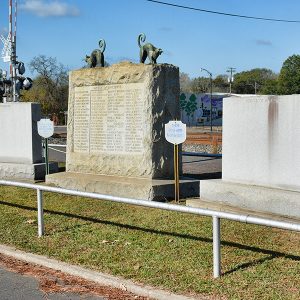calsfoundation@cals.org
Hoo-Hoo Monument
The Hoo-Hoo Monument, built in 1909 and located in the southeastern corner of the Missouri Pacific Railroad Depot parking lot at North 1st and Main streets in Gurdon (Clark County), is a granite and bronze monument with Egyptian Revival detail, designed by artist George J. Zolnay. It was listed on the National Register of Historic Places on September 2, 1999.
The International Concatenated Order of Hoo-Hoo, a fraternal group of lumbermen, was founded in 1892 in Gurdon in the Hotel Hall by Bolling Arthur Johnson and five other men. According to tradition, Johnson—a lumber trade journalist—had for some time seen a need to link together, or “concatenate,” the workers of the timber industry. In 1891, there were many local and state associations for lumbermen in existence, but no national order had been established. In order to promote communications, foster cooperation, and create a shared code of ethics for the lumber industry and its workers, Johnson aspired to create a fraternity of lumbermen. On January 21, 1892, Johnson attended a meeting of the Southern Lumber Manufacturers in Camden (Ouachita County). After the meeting, he and four other conventioneers were stranded in Gurdon for five hours by a delayed train. Johnson, George K. Smith, William Eddy Barns, George W. Schwartz, and William Starr Mitchell left the depot to wait in the parlor at Hotel Hall. There they met local lumberman Ludolph Adalbert Strauss. Johnson shared his ideas about a national fraternity with these five men, and together they organized the Concatenated Order of Hoo-Hoo.
The organization borrowed concepts from historical Egyptian lore for the titles, symbols, and rituals of the new fraternity. A black cat with its tail curved into the number nine was chosen as the order’s emblem. The theme of “nine” from the legendary number of a cat’s lives carried through the organization in the number of jurisdictions, committee memberships, etc.
In 1909, five of the founding members of the Hoo-Hoo Order—Johnson, Barns, Mitchell, Schwartz, and Smith—gathered in Gurdon to dedicate the Hoo-Hoo Monument. The plaque, cast from the copper in pennies donated by Hoo-Hoo members, was affixed to the building that stood on the site of Hotel Hall. In 1927, the building holding the Hoo-Hoo Monument was scheduled for demolition, and the bronze plaque was moved across Main Street to its current location adjacent to the Missouri Pacific Railroad Depot. There, it was affixed to a permanent barre granite base and dedicated for a second time. The bronze plaque inset on the northwestern side is divided into three horizontal levels and is decorated with Egyptian Revival–influenced reliefs and engravings, as well as a small relief of the Hotel Hall. The names of all Hoo-Hoo presidents, or “Snarks of the Universe,” were engraved on the opposite sides of the monument, and two statues of cats, as they appear on the Hoo-Hoo logo, were placed atop the new monument.
Sculptor George J. Zolnay created the sculpture. Zolnay was born in Hungary on July 4, 1863, and came to the United States in 1892. He studied at the Imperial Academy in Vienna, Austria, and the National Academy in Bucharest, Romania, and was a member of artists’ unions in Europe and America. Zolnay specialized in large-scale memorial sculptures and architectural sculptures. In addition to the Hoo-Hoo Monument, he is known to have executed other small-scale bronze works, including the relief panel on the monument for Brigadier General Richard L. Hoxie and his wife at Arlington National Cemetery. Zolnay died on May 1, 1949, in New York City.
The identities of the sculptor of the cats and the fabricator of the granite monument on which the Zolnay plaque is set are unknown; however, these elements have been part of the monument since its 1927 relocation and contribute to the overall integrity of the Hoo-Hoo monument.
After its move to the current location, the Hoo-Hoo Monument remained a center point in the group’s identity. The names of succeeding generations of “Rameses”—the title given to “Snarks of the Universe” after their tenure as president of the organization ended—were engraved on its reverse side, providing additional historic and traditional importance to the monument in its 1927 location and manifestation. In fact, the monument was utilized by the organization continually until 1988, when there was no additional space to inscribe the names of “Snarks.” Two smaller granite monuments were purchased to carry the names of future “Snarks.” Those monuments flank the original monument.
For additional information:
“George Julian Zolnay.” In Who Was Who in American Art, edited by Peter Hastings Falk. Madison, CT: Sound View Press, 1985.
Hoo-Hoo International. http://www.hoo-hoo.org/ (accessed November 6, 2020).
“Hoo-Hoo Monument.” National Register of Historic Places nomination form. On file at Arkansas Historic Preservation Program, Little Rock, Arkansas. Online at http://www.arkansaspreservation.com/National-Register-Listings/PDF/CL0908S.nr.pdf (accessed November 6, 2020).
Newberry, Farrar. “The Concatenated Order of Hoo-Hoo.” Arkansas Historical Quarterly 20 (Spring/Winter 1963): 301–310.
Mark K. Christ
Arkansas Historic Preservation Program


 Concatenated Order of Hoo-Hoo
Concatenated Order of Hoo-Hoo  Hoo-Hoo Monument
Hoo-Hoo Monument 



Ludolph Adalbert Strauss was my great-great-grandfather; he went by Adalbert or later on, Al. He married Ottilie “Tillie” Nulsen and had nine children who lived to be adults.